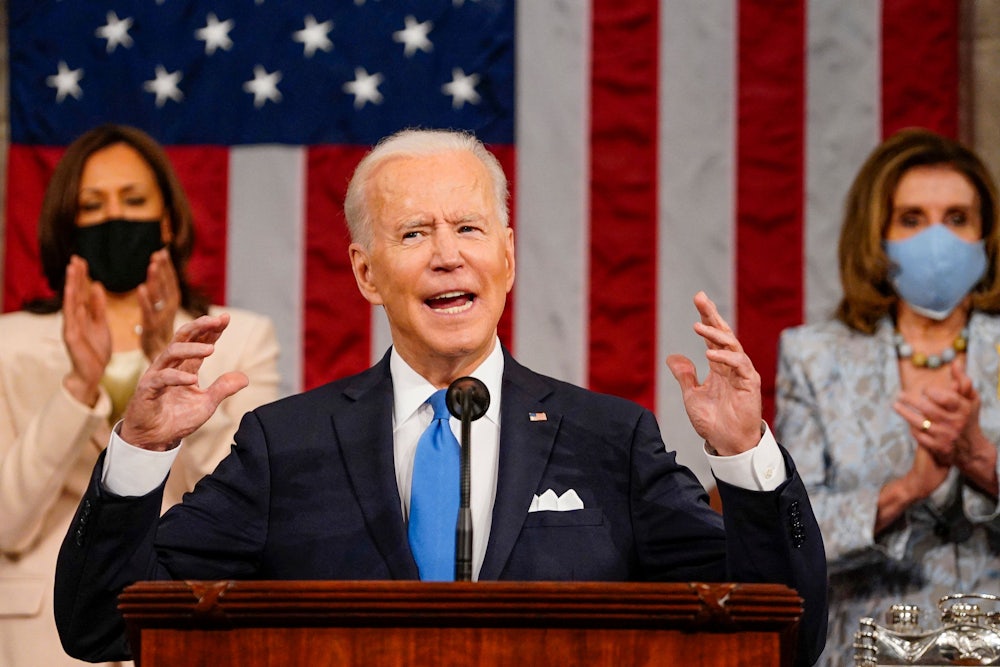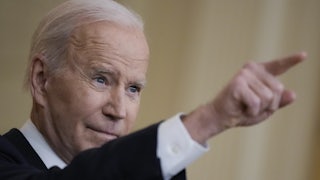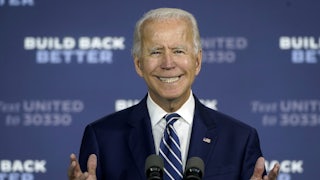President Joe Biden’s first State of the Union address comes at a time of fear and confusion. At core is a frustrating political puzzle. By historical standards, the economy has recovered remarkably well and quickly from the pandemic. Given the state of the world two years ago, when Covid-19 first shut down most of the international economy, jobs, wages, growth, and capital investment are all far better than anyone predicted or expected. And yet the American public is sour. Inflation dominates the headlines. Rising prices are a real problem and a political one, exacerbating and exacerbated by the ongoing chaos of the pandemic.
At the same time, the Russian invasion of Ukraine raises questions about Western resolve and puts questions of international economics—sanctions, supply chains, overseas assets—squarely in the spotlight. Americans’ ire and pain will rise along with skyrocketing energy prices and the ill-gotten gains of war profiteering. It may be, as pundits are saying, that Biden’s image gets a boost from his resolve and leadership in the face of Russian aggression.
But the problems this president faces are still enormous. They also create a crossroads. This is a real choice point for the Biden presidency. Tuesday’s speech provides the president the opportunity to get out from behind the eight ball. With his favorability so low, he has nothing to lose and everything to gain by going big, telling the aspirational, forward-looking, and fact-based story about the country and our future that he wants voters to hear.
Biden should pull together threads that he hinted at on the campaign trail and during his first 100 days in office but has yet to fully nail down. There is a story for him to tell: a new common sense about how the economy could work, and for whom, if government uses its full powers to shape our shared direction. A new vision of international economic alliances, to what end, and on whose terms. And the ways in which an equitable and more vibrant economy—high-care, low-carbon, affirmatively inclusive—is required to win the battle for democracy, at home and abroad.
This is no distant fantasy. It’s based on work his team has already done that rarely makes headlines, but could—with real political support and in tandem with international allies—move us past today’s instability.
The story we should be hearing
Biden will of course need to address inflation in his speech. But he should leave explaining the causes of current inflation—which economists are currently and rightly debating—to the wonks. He should instead focus on his administration’s actual, though nascent, achievements, reminding us that only government can do the big things necessary to remake a broken public and that government, in Franklin D. Roosevelt’s words, “is ourselves, and not some alien power over us.”
Federal action has four parts:
- Direct spending for struggling families, cities, and states.
- Strategic industrial policy, investing in future economic sectors that the market would otherwise fail.
- Competition policy, making sure that corporate actors are right-sized, not choking off further growth and innovation.
- International economic relations, or trade policy, that focuses on workers, decarbonized production, and robust supply chains—to build resilience rather than dependence.
It’s hard to weave all of this into a whole, especially when policy so often comes in long wish lists that feel both utopian and disjointed. But I hope Biden can help us see how different federal powers could shape a more egalitarian economy that, once established, can itself generate better outcomes.
Direct Spending
Since the beginning of the pandemic, the federal government has put massive fiscal policy—over $5 trillion, a staggering sum—in play. We sent hundreds of billions to struggling cities and states, the opposite of what happened during the Great Recession. We provided billions in relief for struggling renters. We expanded unemployment insurance to workers who lost their jobs during the pandemic. Though political gridlock has halted payments for now, over the last year the government sent checks directly to struggling Americans so effectively that we eliminated poverty for eight million families, the biggest drop in a half-century.
Record recovery, growth, jobs, and wages are the direct result of government action. I’d wager that most people don’t fully recognize this. Biden needs to connect the dots, describing how the money the government put in people’s pockets to protect them from financial ruin during the height of Covid is now building the economy that, at least since the secular stagnation of the Great Recession, we have wanted to see. Companies are investing capital in new plant and new technologies. There are more jobs available now than we’ve seen in generations, giving workers the power to demand higher wages, better working conditions, and more time off to be with their families. More jobs is an unassailable good, and with enough jobs and better care systems, we can better close persistent employment disparities between men and women and Black and white Americans.
Industrial Policy
But to paint a fuller picture, Biden must discuss, and really show, how his administration has been using the wide range of economic tools at the government’s disposal.
The most important and least understood tool is public investment in specific sectors—green manufacturing, infrastructure of all kinds, education, and caregiving—that won’t flourish fast enough or equitably enough on their own or are vulnerable to supply chain disruption. The Biden administration actually delivered a $1 trillion infrastructure bill: roads, bridges, airports, railroads, public transportation, broadband internet, clean water, the biggest public investment package in at least a generation.
Today’s industrial policy also includes the often underappreciated work of figuring out where industries and markets are not producing the goods we need or are not able to move them where we need them, and then using all of the tools of government to make sure we have the capacity to make and build and provide the services we need to be economically resilient. After a sharp downturn in 2020, manufacturing jobs are growing. The government plan is to invest in domestic production across a number of sectors—rare mineral production, semiconductors—that are essential to making more products, goods, and services to meet demand.
This is also about investing in people, and their futures, throughout the entire country. The administration has already put billions into historically Black colleges and universities and in rural, deindustrialized regions throughout the country.
Americans understand FDR’s push to make the American economy the arsenal of democracy, which made the United States the twentieth century’s manufacturing superpower. They understand JFK’s investment in the space race, which set the stage for today’s technological innovation and wealth. Biden can and should tell today’s story: Our government has a mission to build a high-care, low-carbon future.
Competition Policy
The third chapter of Biden’s economic story should focus on competition policy—regulation to shape markets so they act as they should, enabling innovative entrants rather than allowing big players, from tech monopolies to dominant agricultural or manufacturing firms, to block new actors. The Biden administration has embraced competition policy, long advanced by progressives as a way to check outsize corporate power in the economy, in a variety of ways. Federal Trade Commission Chair Lina Khan is reorienting her entire agency to look at the holistic harms—to workers and wages, to innovative new companies, and to prices—caused by asymmetrical market power. Tim Wu, a member of the White House National Economic Council, is arguing that, in technology and elsewhere, “small is beautiful.” Members of Congress, both progressive and centrist, are proposing an array of antitrust legislation focused on reining in Big Tech; making room for a freer, more local press; and better preventing giants from merging with other giants.
Trade and International Economic Policy
The administration’s trade policy also represents a sea change. Rather than focus on “trade liberalization,” which translates into market access for dominant companies, this administration’s leading trade official has prioritized workers and environmental standards. Rather than emphasizing the benefits of the free market alone, Biden’s emergent strategy rests on several pillars:
● forging agreements, especially in Asia, that focus on labor and environmental standards, shared investments in clean energy and decarbonization, and better digital governance;
● building stronger supply chains and joint approaches for screening investments for national security threats along with European allies;
● building decarbonization standards into trade deals that will benefit U.S. workers and businesses, like the fall 2021 “Green Steel Deal” between the U.S. and the EU.
The effort to focus on new, democratic alliances in international economics is a tall order. But the Financial Times has called this the new zeitgeist and noted that it is not just part of a leftward lurch in U.S. politics, but also a real response to a changing global balance of power given the rise of China. Today, the message about democratic international resilience can be one important part of responding to aggression from Russia.
What we won’t hear tomorrow because this administration hasn’t gone far enough
The State of the Union is the one time a year when the president gets the opportunity to write, in full, his own script. But it’s not all upside. There is more to it than just spending public money on a better future. This is the sunny side of public sector–private sector coordination that Joe Biden has long embraced. But to make the sunny side a reality today requires more aggressive action against dominant companies than this administration has yet put in play. This is important. Dominant private actors—wealthy people and big corporations—have every reason to maintain the fragmented, unequal, and increasingly undemocratic status quo. That is why they must be checked.
The Biden team has avoided wealth taxes, and that is a problem. Taxing the rich can curb corporate power—not just as a way to pay for new programs. Voters support wealth taxes overwhelmingly because they understand it’s a win-win-win: less runaway wealth, more desperately needed public investments, and a more democratic playing field. But this is something the Democratic Party by and large has never been comfortable enough talking about or doing.
The Biden team has also been weak on reining in the power of Big Finance and Big Pharma. After announcing their intent to eliminate intellectual property rights for Covid vaccines, the administration’s unwillingness to engage more aggressively on the TRIPs waiver (to the Trade-Related Aspects of Intellectual Property Rights agreement)—and its reliance, instead, on voluntary philanthropic largesse—is infuriating and tragic.
Progressives have also long argued for policies that curb the power of the financial sector to extract value from the productive economy, to prevent corporations from turning to financial chicanery to generate wealth instead of doing it by creating real public value, and to get ahead of the markets by better controlling vast unregulated new industries, including fintech. Some of the personnel choices from the administration—including to the Consumer Financial Protection Bureau and the Securities and Exchange Commission—are a great start on financial regulation, but many players have yet to act. Stalling on curbing the power of finance is starting to seem like a hallmark of this administration, and it runs directly counter to all the good that public investments might do.
And finally, the Biden team’s efforts at whole-of-government race equity have yet to bear real fruit. Most concerning are signs that the public investment in decarbonization won’t keep Biden’s campaign promise of ensuring that communities of color and people on the front lines are genuine beneficiaries. And until we see more direct action—strengthening anti-discrimination laws; fights against wage theft and occupational segregation—that will benefit workers of color and close the still-yawning Black-white employment gap (worst, as always, for Black women), promises of race equity and gender equity will remain empty.
Democracy: How and why the chapters fit together
The speech I want to hear Tuesday is not about taking credit for what’s gone well, though there is plenty. This is not about placing blame for what has gone poorly, though there’s plenty of blame to go around, and plenty of genuinely bad actors. And I have been around long enough to know that all the wonky detail above won’t make it into the final speech.
But a State of the Union that combines explanation and vision is necessary, available, and sorely needed in a fractured, skittish America. President Biden can begin with what his team has already put in motion toward a clear vision of the world his grandchildren’s grandchildren will inherit. A year after a right-populist invasion of our own capital, and a week after the launch of the worst war in Europe in 80 years, Biden can connect the dots on a vision of global alliances—in Europe and in the Pacific—based on shared values and shared interests.
The hard work to make us more economically resilient, to do this in a way that enhances race and gender equity, and to do this alongside every nation that shares similar aspirations, is part of our larger collective project: to build a vibrant democracy here and around the world. It is about everyone voting. It is about civic participation and better governance of our institutions, public and private. And most of all it is about the social movements that can fight autocracy at home and abroad. As he makes his inaugural State of the Union, I hope Joe Biden reminds us of what he said in December before representatives of more than 100 nations: “Democracy doesn’t happen by accident. We have to renew it with each generation.” This is the contrast the president must make between his own work and the efforts of dictators and autocrats, foreign and domestic.
No president wants his first State of the Union to come amid global chaos and domestic distrust. But these are the cards Joe Biden has been dealt. Today’s crises give the president the opportunity to showcase what his team has already done that goes largely unnoticed, to do better where it has been slow or absent—and most of all to inspire Americans to work together to build the alliances, the goodwill, the affirmative inclusion, and the shared wealth and trust that peace and prosperity require.








